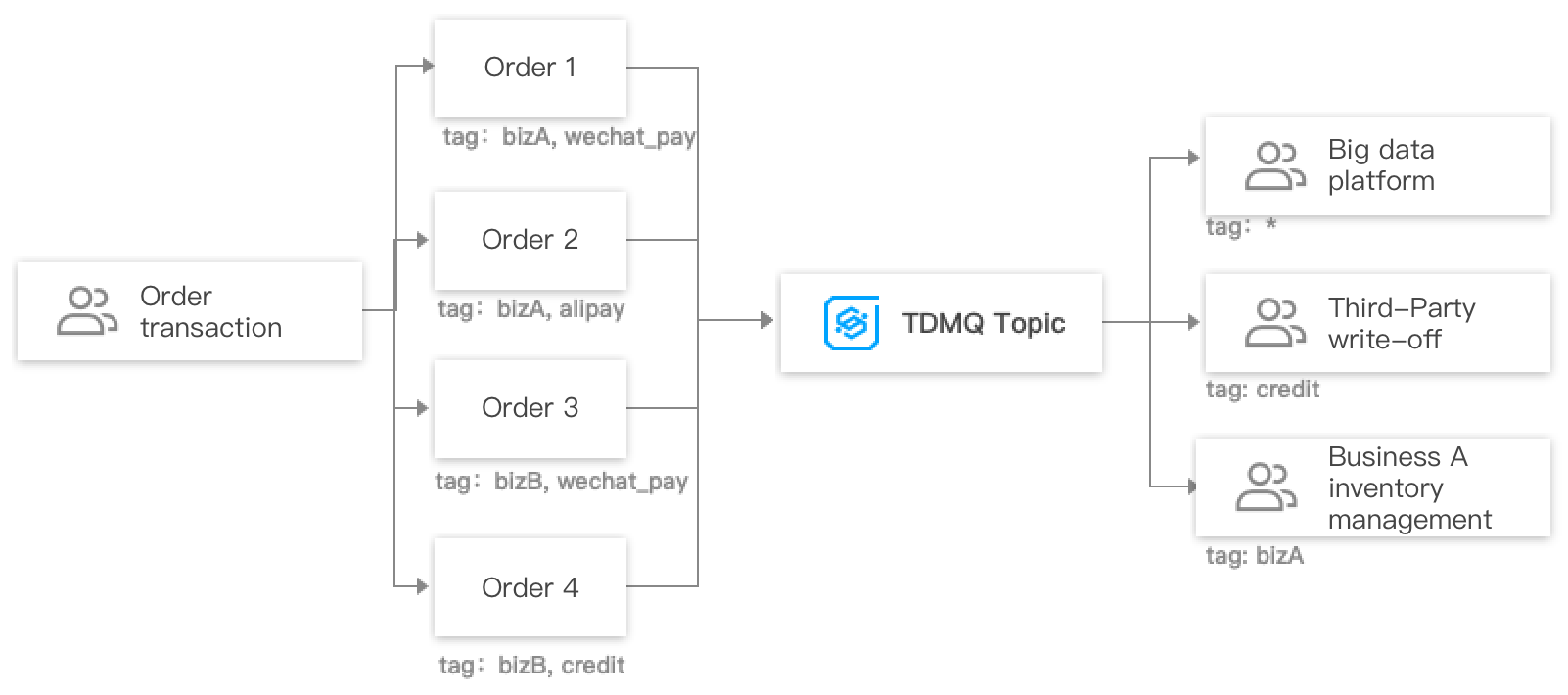本文主要介绍 TDMQ RocketMQ 版中消息过滤的功能、应用场景和使用方式。
功能介绍
消息过滤功能指消息生产者向 Topic 中发送消息时,设置消息属性对消息进行分类,消费者订阅 Topic 时,根据消息属性设置过滤条件对消息进行过滤,只有符合过滤条件的消息才会被投递到消费端进行消费。
消费者订阅 Topic 时若未设置过滤条件,无论消息发送时是否有设置过滤属性,Topic 中的所有消息都将被投递到消费端进行消费。
应用场景
通常,一个 Topic 中存放的是相同业务属性的消息,例如交易流水 Topic 包含了下单流水、支付流水、发货流水等,业务若只想消费者其中一种类别的流水,可在客户端进行过滤,但这种过滤方式会带来带宽的资源浪费。
针对上述场景,TDMQ 提供 Broker 端过滤的方式,用户可在生产消息时设置一个或者多个 Tag 标签,消费时指定 Tag 订阅。


使用方式
TAG 过滤
发送消息
说明:
发送消息时,每条消息必须指明 Tag。
String tag = "yourMessageTagA";final Message message = provider.newMessageBuilder()// Set topic for the current message..setTopic(topic)// Message secondary classifier of message besides topic..setTag(tag)// Key(s) of the message, another way to mark message besides message id..setKeys("yourMessageKey-1c151062f96e").setBody(body).build();
订阅消息
订阅所有 Tag:消费者如需订阅某 Topic 下所有类型的消息,Tag 用星号(*)表示。
String consumerGroup = "yourConsumerGroup";String topic = "yourTopic";String tag = "*";FilterExpression filterExpression = new FilterExpression(tag, FilterExpressionType.TAG);// In most case, you don't need to create too many consumers, singleton pattern is recommended.PushConsumer pushConsumer = provider.newPushConsumerBuilder().setClientConfiguration(clientConfiguration)// Set the consumer group name..setConsumerGroup(consumerGroup)// Set the subscription for the consumer..setSubscriptionExpressions(Collections.singletonMap(topic, filterExpression)).setMessageListener(messageView -> {// Handle the received message and return consume result.log.info("Consume message={}", messageView);return ConsumeResult.SUCCESS;}).build();
订阅单个 Tag:消费者如需订阅某 Topic 下某一种类型的消息,请明确标明 Tag。
String consumerGroup = "yourConsumerGroup";String topic = "yourTopic";String tag = "TAGA";FilterExpression filterExpression = new FilterExpression(tag, FilterExpressionType.TAG);// In most case, you don't need to create too many consumers, singleton pattern is recommended.PushConsumer pushConsumer = provider.newPushConsumerBuilder().setClientConfiguration(clientConfiguration)// Set the consumer group name..setConsumerGroup(consumerGroup)// Set the subscription for the consumer..setSubscriptionExpressions(Collections.singletonMap(topic, filterExpression)).setMessageListener(messageView -> {// Handle the received message and return consume result.log.info("Consume message={}", messageView);return ConsumeResult.SUCCESS;}).build();
订阅多个 Tag:消费者如需订阅某 Topic 下多种类型的消息,请在多个 Tag 之间用两个竖线
||分隔。String consumerGroup = "yourConsumerGroup";String topic = "yourTopic";String tag = "TAGA || TAGB";FilterExpression filterExpression = new FilterExpression(tag, FilterExpressionType.TAG);// In most case, you don't need to create too many consumers, singleton pattern is recommended.PushConsumer pushConsumer = provider.newPushConsumerBuilder().setClientConfiguration(clientConfiguration)// Set the consumer group name..setConsumerGroup(consumerGroup)// Set the subscription for the consumer..setSubscriptionExpressions(Collections.singletonMap(topic, filterExpression)).setMessageListener(messageView -> {// Handle the received message and return consume result.log.info("Consume message={}", messageView);return ConsumeResult.SUCCESS;}).build();
SQL 过滤
发送消息
发送代码和简单的消息没有区别。主要是在构造消息体的时候,带上自定义属性,允许多个。
final Message message = provider.newMessageBuilder()// Set topic for the current message..setTopic(topic)// Message secondary classifier of message besides topic.// Key(s) of the message, another way to mark message besides message id..setKeys("yourMessageKey-1c151062f96e").setBody(body)//一些用于sql过滤的信息.addProperty("key1", "value1").build();
订阅消息
对于消费消息,订阅时需带上相应的 SQL 表达式,其余与普通的消费消息流程无区别。
String consumerGroup = "yourConsumerGroup";String topic = "yourTopic";String sql = "key1 IS NOT NULL AND key1='value1'";//sql表达式FilterExpression filterExpression = new FilterExpression(sql, FilterExpressionType.SQL92);//如果是订阅所有//FilterExpression filterExpression = FilterExpression.SUB_ALL;// In most case, you don't need to create too many consumers, singleton pattern is recommended.PushConsumer pushConsumer = provider.newPushConsumerBuilder().setClientConfiguration(clientConfiguration)// Set the consumer group name..setConsumerGroup(consumerGroup)// Set the subscription for the consumer..setSubscriptionExpressions(Collections.singletonMap(topic, filterExpression)).setMessageListener(messageView -> {// Handle the received message and return consume result.log.info("Consume message={}", messageView);return ConsumeResult.SUCCESS;}).build();
说明:

 是
是
 否
否
本页内容是否解决了您的问题?